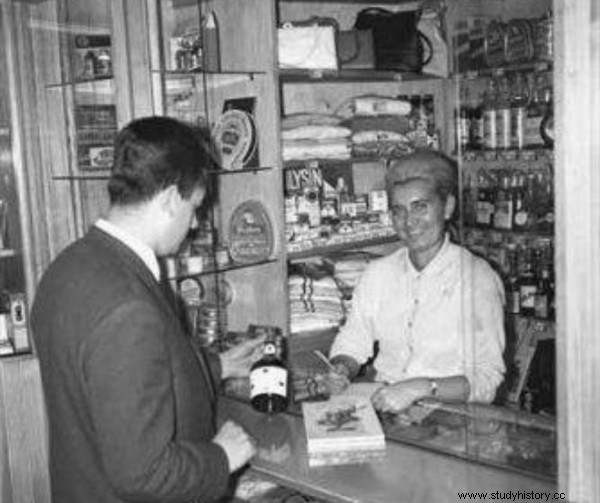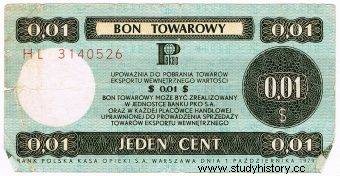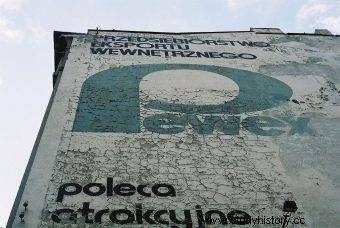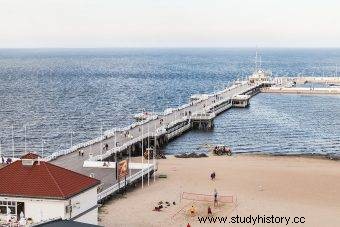Cinkciarze were the kings of the communist era. They sold green to interested parties, and cheated suckers with the rubber band method. It was possible to arrange not only currency with them. The more resourceful ones, especially those driving on tariffs, knew escort girls, finish lines with left alcohol and had contacts in the services.
They bought "paper" from foreigners at airports or in front of hotels, also in taxis, because they often combined two tickets. They used to visit shops such as "Pewex" or "Baltona". They earned several times more than the regular doe.
For 45 years of People's Poland, the communist authorities tried to "extract" money from citizens from the countries of the "second payment zone" - as the "rotten" Western countries were called. In Stalinist times it was impossible to have foreign currency at all. You could go to jail for having even one mark or a dollar . Trade was punishable by the death penalty. The famous film "Reverse" by Borys Lankosz was a great portrayal of those times.

Foreign exchange kiosk at the "Continental" Orbis hotel in Szczecin (1966)
Dollar holders were required to disclose their currency and sell it to the state at a fixed exchange rate - PLN 4 per dollar. It was obviously very undervalued in relation to the black market value of foreign currencies. Therefore, many "green" holders opted for "land banks". Dollars were kept, for example, buried in a jar on the plot, sewn into the mattress, or under the house floor. No wonder that even a few hundred dollars from an uncle or aunt from the USA was a fortune, since the average earnings in the Polish People's Republic, which did not change significantly over the years, amounted to $ 20-30 a month.
The invisible hand of the market
The centrally planned economy has ultimately turned out to be insufficiently tight enough to stave off human entrepreneurship. Despite the official lack of inflation, the citizens of the Polish People's Republic did not trust the Polish zloty. The value of money could change overnight. One decision was enough and the prices of, for example, meat or fuel soared up by several dozen percent .
In addition, the black market dictated the true value of goods in conditions of constant scarcity. Although officially the prices for a product could be low, in fact, with empty shelves, in illegal trade, the rates grew by several hundred percent compared to official ones.

Gift certificate with a nominal value of US $ 0.01
No wonder that, instead of in zlotys, citizens saw an opportunity to preserve the value of capital, in gold or foreign currencies, primarily in dollars. Where from in the country behind the Iron Curtain to get "green"? The sources of foreign currency were those who, for example, received them in letters from foreign relatives (as long as they were not stolen in post offices), or who brought currency from foreign travels - e.g. Polish builders or diplomats. The second source of "greens" was a small group of foreigners who visited the People's Republic of Poland:foreign diplomats, sailors, tourists.
Such a newcomer, who came to the People's Republic of Poland, could exchange his money in a Pekao facility at a foreign exchange rate. Those who were smarter and more experienced in their journeys through socialist Poland, realized that life here has the character of two parallel realities - official and unofficial. They realized that when they left the hotel there would be a guy looking around who would whisper in broken English change money (from the inept pronunciation of this term the name of the cinkciarz comes from) . With such a gentleman, you could exchange the currency much more favorably. In this way, "greens", pounds, marks or francs circulated in the second cycle of the socialist economy.
Polish "dollar" and internal export
Interestingly, although the communist authorities were officially fighting the black market, they urgently needed foreign currency themselves. Huge loans were taken out in Gierek's times. Moreover, the communist country imported a lot from the West. Therefore, after the period of Stalinism, when the course in external and internal politics was eased, the authorities, instead of orders, tried to extract currency from citizens after goodness. Trading in foreign currencies was admittedly still forbidden, but they could be legally owned, and transmissions from an uncle or aunt from "America" became legal.
So apparently the authorities agreed to give the Poles dollars or pounds. In practice, however, there was a trick in this, because the person who received the transfer from abroad at the cash desk at the state-owned Pekao, received not dollars, marks or francs, but their substitute from the Polish People's Republic, valid only here, i.e. Pekao gift certificates. The vouchers were of no value abroad, they were only a worthless piece of paper . It was impossible to pay them outside of Poland or exchange them, but the communists - so that the citizen would not feel a loss - generously allowed him to spend these vouchers on Western goods in the so-called internal export stores.
Such establishments, offering some foreign products and Polish goods of better quality, were established within the Pekao structure. Thus, it was probably the only bank in the world that also dealt, for example, with selling shoes.

Pewex advertisement in Łódź
Internal export stores, later renamed the Pewex and Baltona chains, played two roles. They made it possible to "extract" foreign currencies from Poles (only there, apart from bills, it was possible to pay with foreign currency), and at the same time they gave the state earnings in the form of a monopoly's margin for the sale of Western goods.
In Pewexes, the lucky ones waited for products from the store shelves of the capitalist world - so there were jeans, Mars or Snickers bars, carbonated drinks, branded alcohol and many other products. In addition, dollars could be used to buy Polish goods, sold by Polish state-owned plants - for example nylon jackets, Polar washing machines and others, which, of course, were missing in "ordinary" stores. Nobody was surprised by the absurd situation in which a Pole pays for Polish goods in Poland with dollars ...
Anyway, it was an open secret that the Pewexes were regularly robbed by the employees themselves. There were often fewer "green" cash registers, and when there was a shortage, the seller replenished the lack, only in PLN. This is how the stolen currency found its way to the black market again.
Mafiosi and businessmen
No wonder that money changers stopped near the Pewexes. For the so-called Certain places were also removed from places such as the central station or Hotel Victoria in Warsaw, Cracovia in Kraków, Hotel "Orbis" Poznań, Monopol in Wrocław, Sudetes in Wałbrzych, pier in Sopot, airports, more expensive restaurants.
How much could you earn? In the 1970s, the black market exchange rate was PLN 120–150 per dollar. A qualified "currency maker" could earn even about 15-20 thousand monthly. PLN, which is five times more than the average salary in the People's Republic of Poland! An ordinary citizen at that time earned less than PLN 4,000, or about USD 20-30.

For the so-called Certain things were also available in places such as the central station or the Victoria Hotel in Warsaw, or the pier in Sopot
Cinkciarze, who had access to a large amount of foreign currency and were on the market for a long time, could afford to pay the so-called "Stacks" at airports and stations, porters in hotels, waiters in restaurants, taxi drivers, prostitutes. Each of them gave the foreign currency a link to the currency exchange or sold it himself in return for a commission.
It was those who turned the greens who were creating the seeds for the future mafia of the 90s . The bosses of the Polish underworld of the first decade of capitalism came from this milieu, to mention, for example, Nikodem Skotarczak pseud. "Nikos", who was a money changer for some time. He sold currencies and cheated "foreign" not only in Poland, but also in Hungary and Budapest.
Sztos - on a wajchę, an eraser, a bookmark
The slang at the time distinguished a money changer and a "wajcharz" who cheated the client on the so-called a tab, a wajchę, or an eraser. He handed the foreigner a bundle of real banknotes in his hand, but not the full amount. When the buyer protested after the counting, the switch apologized to him and assured him that he would replace the missing item. Finally, after distracting the buyer, he would push him a lame file, only enveloped in currencies, inside full of cut newspapers . A scam for a larger amount was commonly known as a stump.
The times of money-making passed with the end of the People's Republic of Poland. On March 15, 1989, the government of Mieczysław Rakowski opened the free currency market in Poland. It is said that the well-informed money changers knew exactly when it would happen. They were the first to enter a new era of legal, capitalist business with their new money changers. This is how the first fortunes of the Third Republic of Poland were born. It was a real hit of Polish money changers.
Bibliography:
- Iwona Kienzler: Chronicle of the PRL 1944–1989 . T. 33:Economy and money, Warsaw 2017
- Dariusz T. Grala: Economic reforms in the Polish People's Republic (1982–1989), Warsaw 2005
- Wojciech Morawski: The history of banking in Poland:The specificity of banking in the People's Republic of Poland (half.). They say Ages. [accessed on August 18, 2021]
- Marek Przybylik:It was like this. Market Day . Warsaw:Latarnik Publishing Institute, 2009
